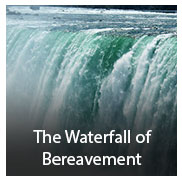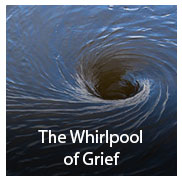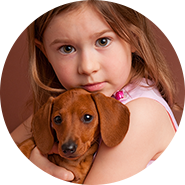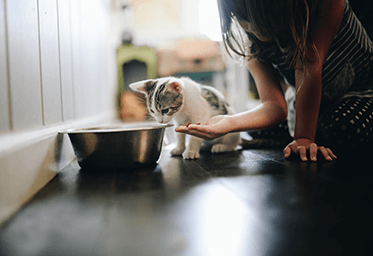Bereavement
Differentiating between Bereavement, Grief and Mourning
Understand the definitions of bereavement, grief and mourning and what circumstances can cause these emotions.
Select each icon to learn about the definition.
Grief
Mourning
The Passing of Kelly
Let’s now look at the sad passing of Kelly the dog.
 Select arrows to navigate.
Select arrows to navigate.
Kelly’s illness and death - Pause and Think
What is the experience of losing a loved one called?
 Select the appropriate options from the choices below.
Select the appropriate options from the choices below.
Causes of Grief
People can experience grief for a number of reasons. Circumstantial and developmental losses can cause feelings of loss and grief.
A circumstantial loss does not necessarily happen to everyone and is circumstantial, whereas developmental losses are inevitable and part of the process of development.
 Select each tile to view examples of these losses.
Select each tile to view examples of these losses.
Stages of Grief
Everybody goes through a series of emotions when experiencing loss. Elizabeth Kubler Ross precisely calls this the stages of grief.
She lists five stages of grief and believes that a person who is grieving will go through these stages and then finally comes to terms with the loss.
Select each tile to reveal the stages.
Denial
Numbness is a normal reaction to the death of a loved one. We may feel that the world has become meaningless and overwhelming. Denial protects us from the intensity of the loss. It allows us to find a simple way to get through the day. Denial helps us to pace our feelings of grief and is a normal part of grief.
Anger
It is common to feel anger towards the loved one for leaving or towards the veterinary professionals for not being able to cure the patient. Sometimes anger can directed towards a higher power.
It is important to allow feelings of anger to run their course. Anger is a necessary part of the healing process and can be the bridge from the numbness of denial and loss.
Bargaining
This stage may be marked by persistent thoughts “I will do anything if you let my dog live.” Some people may become obsessed thinking about specific ways things could have gone differently to prevent the loss. If left unaddressed feelings of guilt can interfere with the healing process.
Depression
Depression over the death of a loved one is not a mental health illness; it is an appropriate response to loss.
Common signs of depression include trouble sleeping, loss of appetite, and fatigue. Bereaved owners may even feel physical aches and pains. Feelings of isolation, emptiness and anxiety are also common.
Acceptance
This is not to be confused with accepting or becoming ok with the loss. Most people do not ever feel ok about what happened to their loved one.
We often hear from owners that they never “get over” the loss. They learn to live without their pet and that the feelings of loss slowly subside but never completely go.
Acceptance is learning to live in this new reality without their loved one. To start living again.
Bereavement - The Whirlpool of Grief
An alternative way to describe grief is by using the metaphor of a whirlpool of grief.
It is helpful to remind pet owners that although things are difficult at that moment due to the loss of a pet, there is a light at the end of the tunnel and what they are feeling is normal.

Select each image to view the process of bereavement.
How People React to Grief
Grief is the natural reaction to loss. As we have already learned, grief is accompanied by physical symptoms. Factors that can influence grief include:
- Attachment and loss history
- Age, stage, culture and gender
People in different age groups have a different outward expression of grief. Let’s learn about how people in different age groups mourn.
Children and Grief
The challenge in talking to children about pet loss is knowing how much they already understand.
Very young children will respond to the emotions around them and pick-up the feelings of grief from family members.
Children of different ages react to death differently.
 Select each image to learn more.
Select each image to learn more.
Young Adults, Couples and Grief
Millennials are putting off marriage and starting a family until later in life than previous generations. This raises some issues when considering how they may react to losing a pet. It is entirely possible for the couple concerned to have strong parental emotions associated with their pets.
- For couples delaying parenthood, furry creatures can become as important as a child event to the point where couples are stating that they see their pets as surrogate or trial children.
- For unmarried single people, a pet loss is equal to the loss of a companion.
![]()

Older People and Grief
It is common for older people to say that they are closer to their “chosen family”, that is, the pet than other people.
 Select each image to view the connection and implications of pet loss in older people.
Select each image to view the connection and implications of pet loss in older people.
Factors that Influence Grief
What are the factors that influence grief?
Select each tile to learn more.
Anticipatory Grief
![]() Select the PDF icon to view a case study about Anticipatory Grief.
Select the PDF icon to view a case study about Anticipatory Grief.
Sudden Grief
Death of a loved one may occur without warning. Late diagnosis of a terminal illness or a fatal accident can leave family members shocked and numb at how quickly they lost their pet.
A sudden death can make the grieving process more difficult than if there had been time to prepare for the loss.
Relationship
The type of relationship you had with the deceased can influence how you grieve. It does not matter whether the deceased was a friend, family member or a pet. If you had a close relationship, it is likely that your grief may be deeper than for someone that had less influence in your life. This explains how some people report stronger feelings of loss and grief for their pet than the loss they feel for an estranged family member.
This is particularly relevant at the end of an assisted partnership. The owner has come to rely on the support they receive from their companion. This forms an incredibly strong bond between human and animal.
Previous Life Experience
Life experiences can influence how people grieve. As a child, was the owner shielded from grief by his/her parents? If that was the case, the owner may have learned that hiding grief was the correct way to behave, or did the person’s parents allow the expression of grief and feelings of loss?
Support System
The importance of your support system cannot be underestimated. It is important to surround yourself with people that understand that your grief is a cause of pain. It is the grief and the pain it causes that is important, rather than whether you are grieving for a person or for a pet.
Mourning
Cultural and religious beliefs heavily influence how people mourn. For example, in most European countries, people in mourning often wear black or a simple black armband, whereas the sign of mourning as a Buddhist or Hindu is white.
Understanding when grief is complete
Knowing when mourning is complete:
- The acute feelings of loss fade
- Any feelings of guilt associated with “moving on” pass
- You can reminisce about your lost companion without feeling a painful absence.
Activity - Personal Loss Timeline
Now that you have learned about love, loss and grief, attempt this activity again.
List all personal losses/bereavement that you have experienced in your life.
 Select the Personal Losses Timeline button to list your losses.
Select the Personal Losses Timeline button to list your losses.

























